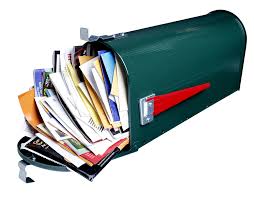 A client called and asked for a little help with their upcoming direct mail solicitation. As a result, all I’ve had on my mind over the last few days is direct mail. So, it only made sense to blog about it today. I’m breaking this post down into small sections, and I’m doing so in the order of highest importance (e.g. the first section has a bigger impact on the performance of your mailing than the second section, etc)
A client called and asked for a little help with their upcoming direct mail solicitation. As a result, all I’ve had on my mind over the last few days is direct mail. So, it only made sense to blog about it today. I’m breaking this post down into small sections, and I’m doing so in the order of highest importance (e.g. the first section has a bigger impact on the performance of your mailing than the second section, etc)
Before I begin, I offer this disclaimer (and then a disclaimer to the disclaimer) . . . I am not a direct mail expert. However, with that being said I believe all of us are “quasi-experts” because we all receive mail and if we’re paying attention then we know what works and what doesn’t work (at least from our perspective). Don’t sell your intuition short and always remember to: “Use the force, Luke.”
The List
 Perhaps, the biggest factor in the success of your direct mail appeal is your mailing list. The following are just a few donor segments that I’ve mailed to throughout the years:
Perhaps, the biggest factor in the success of your direct mail appeal is your mailing list. The following are just a few donor segments that I’ve mailed to throughout the years:
- current donors
- lapsed donors
- donors to a specific special event who you are trying to crossover into an annual campaign
- new donor prospects (cold lists being used for acquisition purposes)
Your response will vary depending on your audience. For example, you will most likely get a better response rate and raise more money by mailing to people who already give to you. Why? Because they know you. They love you. They know what they’re investing in and understand the return on investment.
Which donor niche most likely to yield the lowest response rate? Your cold list of prospects . . . people who don’t contribute yet.
Not only does the character of the list, in and of itself, typically determine campaign performance, but it should also inform your strategies and tactics. Here are just a few examples:
- letter content will likely be different for lapsed donors compared to new prospects
- follow-up recognition and stewardship messaging and strategies might look and sound different for new prospects compared to returning donors
The Outer Package
 Your beautifully crafted letter means nothing if the recipient of your mailing doesn’t open the envelope. Right?
Your beautifully crafted letter means nothing if the recipient of your mailing doesn’t open the envelope. Right?
For this reason, you need to put some thought into what the package looks and feels like. Here are just a few strategies I’ve read about and experimented with throughout the years:
- use pictures and teaser phrases on the outside envelope to encourage people to open the envelope
- use actual stamps (e.g. first class or non-profit bulk stamps) because they allegedly get a higher open rate than an envelope using an indicia
- use color enveloped because get opened more regularly than a standard white one (or at least put color on the white envelope)
- use an odd sized package because they allegedly get opened more often than a standard #10 envelope
- hand address envelopes (when practical) because those letters allegedly get opened more often than those with labels and windows
The psychology of direct mail is complex and every expert has their own opinion. My suggestions are:
- Google around, read some of the data out there, and develop your own point of view
- Test, test, test . . . try different approaches and track your results
- Pull together focus groups of donors or prospects and ask their opinions
Always remember that the more you personalize your mailing, the better off you will be.
The Letter
If you are lucky enough to get someone to open your envelope, a good rule of thumb is to design your letter with the understanding that most readers will spend 10 seconds or less with your appeal.
I suggest you focus on making the following parts of your letter pop because these are the components most commonly viewed by readers in the first five to 10 seconds:
- salutation (make it personal and get it right)
- first paragraph (don’t beat around the bush and ask for specific contribution amount right off the bat)
- signatory (customize who is signing the letter based on relationship with reader or secure well-known and respected person in your community)
- post script (most people read the PS so use it right by reiterating your call to action and tell them how to participate)
Lots of experts have lots of advice when it comes to your letter. Here is some of the advice I’ve personally subscribed to throughout the years:
- tell a story and make it emotional (focusing on heroes and villains puts you on the right track )
- ask for a specific contribution amount
- bold/italicize/underline a few words or sentences that are most important and convey your message
- don’t pack the letter with lots of words . . . less is more
- write the letter using a conversational style (don’t worry about what your 7th grade grammar teacher told you)
- focus more on the donor and less on your agency (use the word YOU)
- when referencing yourself and your agency don’t use the “royal WE” . . . make it personal and use “I”
- white space and pictures of people (especially cute kids and animals if applicable to your mission) are preferable to lots of words
- larger fonts and more space between sentences accommodates your more mature donors
I could literally go on and on and on, but you don’t have time for that this morning. If you are interested in doing more research, the following are a few of the people I love to read on this subject:
What has been your organization’s experience with targeted or direct mail? Please scroll down and share your thoughts and experiences in the comment box below. Why? Because we can all learn from each other.
Here’s to your health!
Erik Anderson
Founder & President, The Healthy Non-Profit LLC
www.thehealthynonprofit.com
erik@thehealthynonprofit.com
http://twitter.com/#!/eanderson847
http://www.facebook.com/eanderson847
http://www.linkedin.com/in/erikanderson847

2 comments